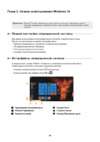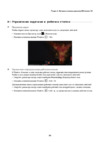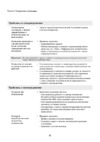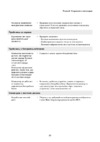Moxa EDS-518E-4GTXSFP-T [53/116] Sample applications of vlans using moxa switches
![Moxa EDS-518E-4GTXSFP-T [53/116] Sample applications of vlans using moxa switches](/views2/1195651/page53/bg35.png)
Managed Ethernet Switch (UI_2.0_FW_5.x) Featured Functions
3-40
The Moxa switch supports three types of VLAN port settings:
• Access Port: The port connects to a single device that is not tagged. The user must define the default port
PVID that assigns which VLAN the device belongs to. Once the ingress packet of this Access Port egresses
to another Trunk Port (the port needs all packets to carry tag information), the Moxa switch will insert this
PVID into this packet so the next 802.1Q VLAN switch can recognize it.
• Trunk Port: The port connects to a LAN that consists of untagged devices, tagged devices, and/or switches
and hubs. In general, the traffic of the Trunk Port must have a Tag. Users can also assign a PVID to a Trunk
Port. The untagged packet on the Trunk Port will be assigned the default port PVID as its VID.
• Hybrid Port: The port is similar to a Trunk port, except users can explicitly assign tags to be removed from
egress packets.
The following section illustrates how to use these ports to set up different applications.
Sample Applications of VLANs Using Moxa Switches
In this application:
• Port 1 connects a single untagged device and assigns it to VLAN 5; it should be configured as an Access
Port with PVID 5.
• Port 2 connects a LAN with two untagged devices belonging to VLAN 2. One tagged device with VID 3 and
one tagged device with VID 4. It should be configured as a Hybrid Port with PVID 2 for untagged device
and Fixed VLAN (Tagged) with 3 and 4 for tagged device. Since each port can only have one unique PVID,
all untagged devices on the same port must belong to the same VLAN.
• Port 3 connects with another switch. It should be configured as a Trunk Port. GVRP protocol will be used
through the Trunk Port.
• Port 4 connects a single untagged device and assigns it to VLAN 2; it should be configured as an Access
Port with PVID 2.
• Port 5 connects a single untagged device and assigns it to VLAN 3; it should be configured as an Access
Port with PVID 3.
• Port 6 connect a single untagged device and assigns it to VLAN 5; it should be configured as an Access Port
with PVID 5.
• Port 7 connects a single untagged device and assigns it to VLAN 4; it should be configured as an Access
Port with PVID 4.
After the application is properly configured:
• Packets from Device A will travel through Trunk Port 3 with tagged VID 5. Switch B will recognize its VLAN,
pass it to port 6, and then remove tags received successfully by Device G, and vice versa.
Содержание
- Edition 1 august 2016 1
- Moxa managed ethernet switch ui_2 _fw_5 x user s manual 1
- Www moxa com product 1
- Copyright notice 2
- Disclaimer 2
- Moxa managed ethernet switch ui_2 _fw_5 x user s manual 2
- Technical support contact information 2
- Trademarks 2
- Www moxa com support 2
- Table of contents 3
- About this manual 5
- Getting started 6
- Managed ethernet switch ui_2 _fw_5 x getting started 7
- Usb console configuration 115200 none 8 1 vt100 7
- Managed ethernet switch ui_2 _fw_5 x getting started 8
- Managed ethernet switch ui_2 _fw_5 x getting started 9
- Configuration by command line interface cli 10
- Managed ethernet switch ui_2 _fw_5 x getting started 10
- Configuration by web console 11
- Managed ethernet switch ui_2 _fw_5 x getting started 11
- Managed ethernet switch ui_2 _fw_5 x getting started 12
- Disabling telnet and browser access 13
- Managed ethernet switch ui_2 _fw_5 x getting started 13
- Featured functions 14
- Managed ethernet switch ui_2 _fw_5 x featured functions 15
- System information 15
- System settings 15
- Managed ethernet switch ui_2 _fw_5 x featured functions 16
- Creating a new account 17
- Managed ethernet switch ui_2 _fw_5 x featured functions 17
- User account 17
- Deleting an existing account 18
- Managed ethernet switch ui_2 _fw_5 x featured functions 18
- Modifying an existing account 18
- Managed ethernet switch ui_2 _fw_5 x featured functions 19
- Network 19
- Password login policy 19
- Ip settings 20
- Managed ethernet switch ui_2 _fw_5 x featured functions 20
- Ipv6 neighbor cache 21
- Managed ethernet switch ui_2 _fw_5 x featured functions 21
- Date and time 22
- Daylight saving time 22
- Managed ethernet switch ui_2 _fw_5 x featured functions 22
- Clock source is from local 23
- Clock source is from ntp 23
- Managed ethernet switch ui_2 _fw_5 x featured functions 23
- Time setting 23
- Clock source is from sntp 24
- Managed ethernet switch ui_2 _fw_5 x featured functions 24
- Sntp client settings 24
- Can ethernet switches be designed to avoid the effects of these 25
- Can ethernet switches be designed to avoid the effects of these fluctuations 25
- Fluctuations 25
- How does an ethernet switch affect 1588 synchronization 25
- Ieee 1588 ptp 25
- Managed ethernet switch ui_2 _fw_5 x featured functions 25
- Managed ethernet switch ui_2 _fw_5 x featured functions 26
- Ptp settings 26
- Managed ethernet switch ui_2 _fw_5 x featured functions 27
- Managed ethernet switch ui_2 _fw_5 x featured functions 28
- Ptp port settings 28
- Ptp status 28
- Managed ethernet switch ui_2 _fw_5 x featured functions 29
- System event settings 29
- Warning notification 29
- Managed ethernet switch ui_2 _fw_5 x featured functions 30
- Severity 30
- Managed ethernet switch ui_2 _fw_5 x featured functions 31
- Port event settings 31
- Severity 31
- Email settings 32
- Event log settings 32
- Managed ethernet switch ui_2 _fw_5 x featured functions 32
- Managed ethernet switch ui_2 _fw_5 x featured functions 33
- Syslog server settings 33
- Managed ethernet switch ui_2 _fw_5 x featured functions 34
- Relay warning status 34
- Mac address table 35
- Managed ethernet switch ui_2 _fw_5 x featured functions 35
- Auto backup configurator abc 02 36
- Firmware upgrade 36
- Managed ethernet switch ui_2 _fw_5 x featured functions 36
- System files 36
- Tftp server 36
- Auto backup configurator abc 02 37
- Configuration backup and restore 37
- Managed ethernet switch ui_2 _fw_5 x featured functions 37
- Tftp server 37
- Auto backup configurator abc 02 38
- Auto backup of event log to prevent overwrite 38
- Log file backup 38
- Managed ethernet switch ui_2 _fw_5 x featured functions 38
- Tftp server 38
- Managed ethernet switch ui_2 _fw_5 x featured functions 39
- Switch reset button 39
- Turbo ring dip switch 39
- Factory default 40
- Managed ethernet switch ui_2 _fw_5 x featured functions 40
- Restart 40
- Managed ethernet switch ui_2 _fw_5 x featured functions 41
- Poe poe models only 41
- Poe settings 41
- Managed ethernet switch ui_2 _fw_5 x featured functions 42
- Poe power management by allocated power 42
- Poe power management by measured power 42
- Poe system configuration 42
- Managed ethernet switch ui_2 _fw_5 x featured functions 43
- Poe port configuration 43
- Poe system configuration settings 43
- Managed ethernet switch ui_2 _fw_5 x featured functions 44
- Managed ethernet switch ui_2 _fw_5 x featured functions 45
- Poe device failure check 45
- Managed ethernet switch ui_2 _fw_5 x featured functions 46
- Poe timetabling 46
- Poe warning event settings 46
- Event type 47
- Managed ethernet switch ui_2 _fw_5 x featured functions 47
- Warning type 47
- Diagnose configuration 48
- Managed ethernet switch ui_2 _fw_5 x featured functions 48
- Poe diagnose 48
- Managed ethernet switch ui_2 _fw_5 x featured functions 49
- Monitoring configuration 49
- Poe port status 49
- Pse status 49
- Managed ethernet switch ui_2 _fw_5 x featured functions 50
- Poe system status 50
- Port status 50
- Managed ethernet switch ui_2 _fw_5 x featured functions 51
- Monitoring configuration 51
- System power status 51
- The virtual lan vlan concept 51
- What is a vlan 51
- Benefits of vlans 52
- Communication between vlans 52
- Managed ethernet switch ui_2 _fw_5 x featured functions 52
- Managing a vlan 52
- Vlans and the rackmount switch 52
- Vlans tagged and untagged membership 52
- Managed ethernet switch ui_2 _fw_5 x featured functions 53
- Sample applications of vlans using moxa switches 53
- Configuring a virtual lan 54
- Managed ethernet switch ui_2 _fw_5 x featured functions 54
- Quick setting panel 54
- Vlan settings 802 q 54
- Attention 55
- Managed ethernet switch ui_2 _fw_5 x featured functions 55
- Vlan id configuration table 55
- Managed ethernet switch ui_2 _fw_5 x featured functions 56
- Vlan name setting 56
- Vlan settings port based 56
- Managed ethernet switch ui_2 _fw_5 x featured functions 57
- Qinq settings 57
- Vlan table 57
- Managed ethernet switch ui_2 _fw_5 x featured functions 58
- Port settings 58
- Link aggregation 59
- Managed ethernet switch ui_2 _fw_5 x featured functions 59
- Port status 59
- Managed ethernet switch ui_2 _fw_5 x featured functions 60
- Port trunking 60
- The port trunking concept 60
- Link swap fast recovery 61
- Managed ethernet switch ui_2 _fw_5 x featured functions 61
- Trunking status 61
- Benefits of multicast 62
- Managed ethernet switch ui_2 _fw_5 x featured functions 62
- Multicast 62
- Multicast filtering 62
- The concept of multicast filtering 62
- What is an ip multicast 62
- Managed ethernet switch ui_2 _fw_5 x featured functions 63
- Multicast filtering and moxa s industrial rackmount switches 63
- Enabling multicast filtering 64
- Gmrp garp multicast registration protocol 64
- Igmp multicast filtering 64
- Managed ethernet switch ui_2 _fw_5 x featured functions 64
- Static multicast mac 64
- Igmp snooping 65
- Igmp snooping setting 65
- Managed ethernet switch ui_2 _fw_5 x featured functions 65
- Igmp group status 66
- Managed ethernet switch ui_2 _fw_5 x featured functions 66
- Managed ethernet switch ui_2 _fw_5 x featured functions 67
- Static multicast address 67
- Stream table 67
- Managed ethernet switch ui_2 _fw_5 x featured functions 68
- Multicast filtering behavior 68
- Ieee 802 d traffic marking 69
- Managed ethernet switch ui_2 _fw_5 x featured functions 69
- The traffic prioritization concept 69
- Differentiated services diffserv traffic marking 70
- Managed ethernet switch ui_2 _fw_5 x featured functions 70
- Traffic prioritization 70
- Traffic queues 70
- Configuring traffic prioritization 71
- Cos classification 71
- Managed ethernet switch ui_2 _fw_5 x featured functions 71
- Managed ethernet switch ui_2 _fw_5 x featured functions 72
- Priority mapping type 1 72
- Dscp mapping 73
- Managed ethernet switch ui_2 _fw_5 x featured functions 73
- Priority mapping type 2 73
- Managed ethernet switch ui_2 _fw_5 x featured functions 74
- Rate limiting 74
- Type 1 74
- Egress rate limit 75
- Ingress rate limit 75
- Managed ethernet switch ui_2 _fw_5 x featured functions 75
- Rate limiting normal 75
- Managed ethernet switch ui_2 _fw_5 x featured functions 76
- Rate limiting port disable 76
- Type 2 76
- Managed ethernet switch ui_2 _fw_5 x featured functions 77
- Rate limiting drop packet 77
- Rate limiting port disable 77
- Managed ethernet switch ui_2 _fw_5 x featured functions 78
- Rate limiting drop packet 78
- Type 3 78
- Managed ethernet switch ui_2 _fw_5 x featured functions 79
- Rate limiting port disable 79
- Type 4 79
- Egress rate limit 80
- Ingress rate limit 80
- Managed ethernet switch ui_2 _fw_5 x featured functions 80
- Rate limiting normal 80
- Management interface 81
- Rate limiting port disable 81
- Security 81
- Managed ethernet switch ui_2 _fw_5 x featured functions 82
- Managed ethernet switch ui_2 _fw_5 x featured functions 83
- Trusted access 83
- Authentication 84
- Login authentication 84
- Managed ethernet switch ui_2 _fw_5 x featured functions 84
- Ssh key management 84
- Ssl certificate management 84
- Managed ethernet switch ui_2 _fw_5 x featured functions 85
- Ieee 802 x settings 86
- Managed ethernet switch ui_2 _fw_5 x featured functions 86
- Managed ethernet switch ui_2 _fw_5 x featured functions 87
- Ieee 802 x local database 88
- Managed ethernet switch ui_2 _fw_5 x featured functions 88
- Mac authentication bypass settings 89
- Managed ethernet switch ui_2 _fw_5 x featured functions 89
- Managed ethernet switch ui_2 _fw_5 x featured functions 90
- Radius server settings 90
- Managed ethernet switch ui_2 _fw_5 x featured functions 91
- Port security 91
- Port security mode 91
- Managed ethernet switch ui_2 _fw_5 x featured functions 92
- Static port lock 92
- Mac address sticky 93
- Managed ethernet switch ui_2 _fw_5 x featured functions 93
- Broadcast storm protection 94
- Managed ethernet switch ui_2 _fw_5 x featured functions 94
- Port access control table 94
- Access control list 95
- Benefits of acl 95
- Loop protection 95
- The acl concept 95
- What is acl 95
- Access control list configuration and setup 96
- Access control profile settings 96
- Add modify access control list 96
- How an acl works 96
- Managed ethernet switch ui_2 _fw_5 x featured functions 96
- Access control rule settings 97
- Adjust acl id 97
- Ip based layer 2 device 97
- Managed ethernet switch ui_2 _fw_5 x featured functions 97
- Ip based layer 3 device 98
- Managed ethernet switch ui_2 _fw_5 x featured functions 98
- Mac based layer 2 device 99
- Mac based layer 3 device 100
- Managed ethernet switch ui_2 _fw_5 x featured functions 100
- Access control list table 101
- Dhcp relay agent 101
- Ip port binding 101
- Dhcp relay agent option 82 102
- Managed ethernet switch ui_2 _fw_5 x featured functions 102
- Dhcp function table 103
- Dhcp option 82 103
- Managed ethernet switch ui_2 _fw_5 x featured functions 103
- Server ip address 103
- Managed ethernet switch ui_2 _fw_5 x featured functions 104
- Managed ethernet switch ui_2 _fw_5 x featured functions 105
- Snmp read write settings 105
- Managed ethernet switch ui_2 _fw_5 x featured functions 106
- Snmp trap mode inform 106
- Snmp trap mode trap 106
- Trap settings 106
- Diagnostics 107
- Industrial protocols 107
- Overview 107
- Configuring lldp settings 108
- General settings 108
- Lldp table 108
- Managed ethernet switch ui_2 _fw_5 x featured functions 108
- Port mirroring 108
- Cpu memory utilization 109
- Managed ethernet switch ui_2 _fw_5 x featured functions 109
- Monitoring 109
- Managed ethernet switch ui_2 _fw_5 x featured functions 110
- Statistics 110
- Fiber digital diagnostics monitoring sfp ddm and fiber 111
- Managed ethernet switch ui_2 _fw_5 x featured functions 111
- Fiber check 112
- Managed ethernet switch ui_2 _fw_5 x featured functions 112
- Sfp digital diagnostic monitor 112
- Fiber check threshold values 113
- Managed ethernet switch ui_2 _fw_5 x featured functions 113
- Event log 114
- Managed ethernet switch ui_2 _fw_5 x featured functions 114
- Mib groups 115
- Mib ii 0 transmission group 115
- Mib ii 1 snmp group 115
- Mib ii 7 dot1dbridge group 115
- Mib ii icmp group 115
- Mib ii interfaces group 115
- Mib ii ip group 115
- Mib ii system group 115
- Mib ii tcp group 115
- Mib ii udp group 115
- Managed ethernet switch ui_2 _fw_5 x mib groups 116
- Private traps 116
- Public traps 116
Похожие устройства
- Moxa EDS-518E-4GTXSFP-T Технические характеристики
- Moxa EDS-518E-4GTXSFP-T Руководство по аппаратной части
- Moxa EDS-518E-MM-SC-4GTXSFP Инструкция по эксплуатации
- Moxa EDS-518E-MM-SC-4GTXSFP Руководство пользователя Англ.
- Moxa EDS-518E-MM-SC-4GTXSFP Руководство по аппаратной части
- Moxa EDS-518E-MM-SC-4GTXSFP Технические характеристики
- Moxa EDS-518E-MM-SC-4GTXSFP-T Инструкция по эксплуатации
- Moxa EDS-518E-MM-SC-4GTXSFP-T Руководство пользователя Англ.
- Moxa EDS-518E-MM-SC-4GTXSFP-T Руководство по аппаратной части
- Moxa EDS-518E-MM-SC-4GTXSFP-T Технические характеристики
- Moxa EDS-518E-MM-ST-4GTXSFP Инструкция по эксплуатации
- Moxa EDS-518E-MM-ST-4GTXSFP Руководство пользователя Англ.
- Moxa EDS-518E-MM-ST-4GTXSFP Руководство по аппаратной части
- Moxa EDS-518E-MM-ST-4GTXSFP Технические характеристики
- Moxa EDS-518E-MM-ST-4GTXSFP-T Инструкция по эксплуатации
- Moxa EDS-518E-MM-ST-4GTXSFP-T Руководство пользователя Англ.
- Moxa EDS-518E-MM-ST-4GTXSFP-T Руководство по аппаратной части
- Moxa EDS-518E-MM-ST-4GTXSFP-T Технические характеристики
- Moxa EDS-518E-SS-SC-4GTXSFP Инструкция по эксплуатации
- Moxa EDS-518E-SS-SC-4GTXSFP Руководство пользователя Англ.
![Moxa EDS-518E-4GTXSFP-T [53/116] Sample applications of vlans using moxa switches](/img/pdf.png)















